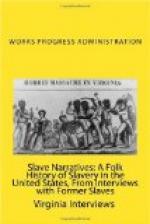“The schools was better out there. I went to Miss Scofield’s College. All the teachers but three was colored. There was eight or ten colored teachers. It was at Aiken, South Carolina. Miss Criley was our sewing mistress. Miss Criley was white and Miss Scofield was too. I didn’t have to pay. Rich folks in the North run the school. No white children went there. I think the teachers was sent there.
“I taught school out here at Blackton and Moro and in Prairie County about. I got tired of it. I married and settled down.
“We owns my home here. My husband was a railroad man. We lives by the hardest.
“I don’t know what becoming of the young generation. They shuns the field work. Times is faster than I ever seen them. I liked the way times was before that last war (World War). Reckon when will they get back like that?”
Interviewer: Miss Irene Robertson
Person interviewed: Henry C. Pettus, Marianna,
Arkansas
Age: 80
“I was born in Wilkes County, near Washington, Georgia. My mother’s owners was Dr. Palmer and Sarah Palmer. They had three boys; Steve, George, and Johnie. They lived in Washington and the farm I lived on was five miles southeast of town. It was fifty miles from Augusta, Georgia. He had another farm on the Augusta Road. He had a white man overseer. His name was Tom Newsom and his nephew, Jimmie Newsom, helped. He was pretty smooth most of the time. He got rough sometimes. Tom’s wife was named Susie Newsom.
“Dick Gilbert had a place over back of ours. They sent things to the still at Dick Gilbert’s. Sent peaches and apples and surplus corn. The still was across the hill from Dr. Palmer’s farm. He didn’t seem to drink much but the boys did. All three did. Dr. Palmer died in 1861. People kept brandy and whiskey in a closet and some had fancy bottles they kept, one brandy, one whiskey, on their mantel. Some owners passed drinks around like on Sunday morning. Dr. Palmer didn’t do that but it was done on some places before the Civil War. It wasn’t against the law to make spirits for their own use. That is the way it was made. Meal and flour was made the same way then.
“Mother lived in Dr. Palmer’s office in Warren County. It was a very nice log house and had a fence to make the front on the road and the back enclosed like. Inside the fence was a tanyard and house at some distance and a very nice log house where Mr. Hudson lived. Dr. Palmer and Mr. Hudson had that place together. The shoemaker lived in Washington in Dr. Palmer’s back yard. He had his office and home all in the same. Mr. Anthony made all the shoes for Dr. Palmer’s slaves and for white folks in town. He made fine nice shoes. He was considered a high class shoemaker.




